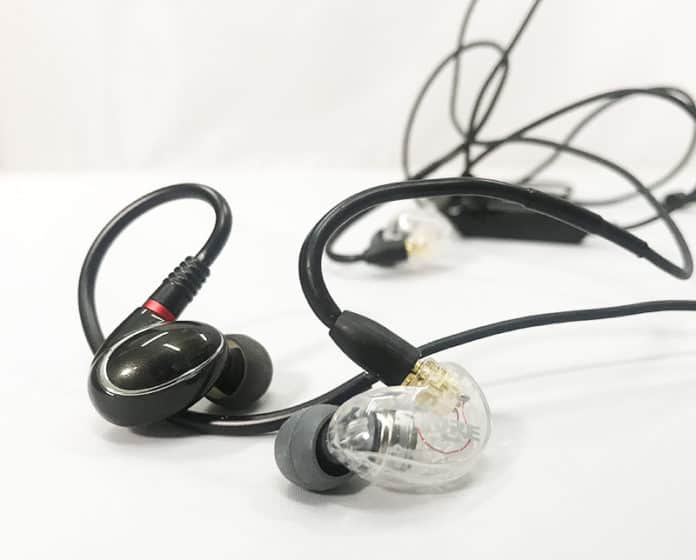If you’re looking for a set of affordable and high-quality in-ear monitors (IEMs), there are a handful of good options out there, and the list just got bigger. You’ve probably heard of the Shure SE215, the powerhouse of IEMs in the $100 price range. But recently, we were able to get our hands on the newest from FiiO, the Fiio FH1. For IEMs that are so similar in look, design, the FiiO FH1 and the Shure SE215 are remarkably different in sound. The FH1 is a little bit more affordable at $74.99, whereas the SE215 is $99. So which one is right for you? Is it worth it for you to spend a little extra cash on the more-well-known 215? Let’s take a closer look with this FiiO FH1 vs Shure SE215 Comparison Review.
FiiO FH1 vs Shure SE215 Comparison Review
In the Box
| FiiO FH1 | Shure SE215 |
| FiiO FH1 earphones | Shure SE215 earphones |
| unbalanced MMCX cable with 3.5 mm connectors (with mic and remote) | unbalanced MMCX cable with 3.5 mm connectors (with mic and remote) |
| balanced MMCX cable with 2.5 mm connector | foam eartips (s, m, l) |
| silicone eartips-balanced (s, m, l) | silicone eartips (s, m, l) |
| silicone eartips-bass (s, m, l) | zipping, soft carrying case |
| hard shell protective carrying case | cleaning tool |
| documentation | documentation |
Design
Look and Feel
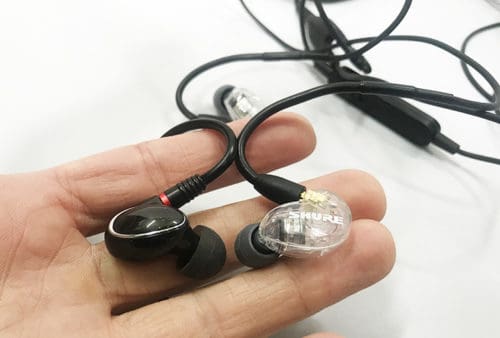
Both the ear pieces of the FiiO FH1 and the Shure SE215 have a very similar rounded shape and medium size. They are both made of plastic and have detachable MMCX cables. Their looks and vibes differ a bit because of their designs. On one hand, the FH1 has a sense of fashion, with a simple line of silver that outlines the shape of the earphone. Its outside finish has a light gloss to it. Additionally, it comes in a number of different colors: black, blue, green, and red. Lastly, the FH1 has a brass tube/nozzle where the eartips fit. It is thicker than the SE215’s nozzle.
On the other hand, the SE215 has a little bit more of a utilitarian design. It’s shell is slightly transparent (except for the white color), so one can see the inner workings of the IEM. The Shure logo goes across the outside with the model number on the opposite side of the shell. Like the FH1, it comes in a few different colors: black, clear, special edition white, and special edition (transparent) blue. Additionally, the nozzle of the SE215 is one with the driver housing and is long and slender in comparison to the FH1’s nozzle.
Comfort and Fit
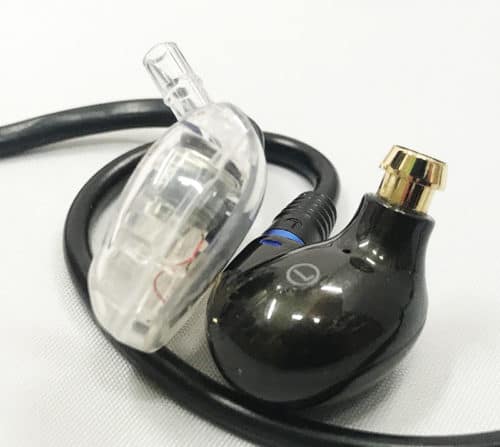
Sitting in my ear, the FiiO FH1 and the Shure SE215 feel very similar. Because of their similarities in shape and size, they both touch the ear in a similar way, although it’s pretty comfortable. Their fit is slightly difference because of the way the cables’ earhooks differ. On one hand, the earhook of the FH1 is more fitted, having a malleable design that returns to its position if you move it.
By contrast, the earhook of the SE215 bends to the position where you move it. But because of the stiffness of the earhook, sometimes it ends up pulling the earphone out of the ear. As a result, it takes a little bit of extra effort to get it to fit. The FH1’s fit is easier and doesn’t require as much finagling for my relatively small ears.
Cables

Both the FiiO FH1 and the Shure SE215 benefit from detachable cables. Their earpieces have MMCX ports where cables can attach. Both IEMs come with an unbalanced MMCX cable with a 3.5 mm connector (with a remote and mic for talking on the phone). Additionally, the FH1 comes with a balanced cable, which I’ll describe below.
However, the cables with the 3.5 mm connectors are quite similar, although feel a bit different from each other. On one hand, the FH1’s cable is softer and easier to coil and manage. It’s remote/mic is more compact and aesthetically pleasing. By contrast, the SE215’s cable feels like it has a thicker jacket, making it a bit stiffer. It feels more hearty than the cable of the FH1.
That said, the FH1’s connector has an “L” shape which helps with strain relief, versus the SE215’s straight connector. In addition to the FiiO FH1’s unbalanced cable, it also comes with a balanced cable with a 2.5 mm connector. This cable is similar to the unbalanced cable in that it utilizes the “L” shaped connector and the same earhook design. It differs in that it is a braided cable with individually insulated conductors.
Drivers
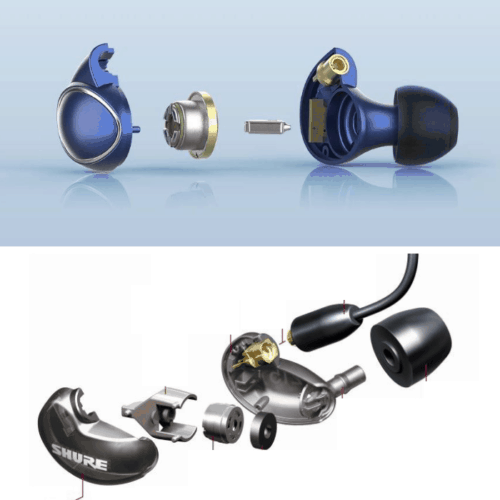
The driver design of the FiiO FH1 and the Shure SE215 are different from each other. This explains their radically different sound signatures despite their similar driver housing shapes. First, the FiiO FH1 features a hybrid driver design. It has one dynamic driver for the lows and a Knowles balanced armature driver for the mids and highs. Fiio says that in order to reduce resonances, they placed the balanced armature driver inside the brass tubing.
By contrast, the Shure SE215 keeps it simple with a single, hi-definition dynamic driver. The special edition versions of the IEM have “distinctly tuned frequency response for extended bass”, according to Shure.
Sound
For this listening test, I tried to make my experience of the earphones as close to each other as possible. I listened with the balanced silicone eartips on both earphones, as well as with their unbalanced cables. For a greater dynamic response and soundstage, listen with the balanced cable of the FiiO FH1. It is worth noting again that because both IEMs have detachable cables, one can use either with any third party MMCX cable, making them super versatile and durable.
Low Frequencies
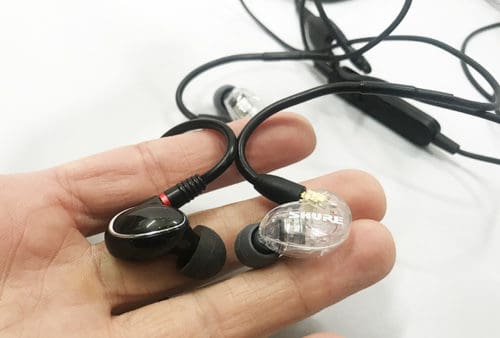
Both the FiiO FH1 and the Shure SE215 have full sounding low ends. However, they are emphasized in slightly different places. On one hand, the FH1 has a little bit of extra emphasis in the sub-region of the lows. Additionally, it has some emphasis near what sounds like 80 Hz. As a result, it has a nice sense of body and thump. Despite these areas of emphasis, there is still a lot of space around the lows which helps it avoid muddiness.
On the other hand, the SE215 has emphasis doesn’t have as much sub energy, but does have extra emphasis around what sounds like 60 Hz and 120 Hz. As a result, kick drums don’t sound as deep as the FH1 but sound a bit louder in the mix.
For example, when I was listening to the song Desperado by Rihanna, the kick sample and the low bass synth sounded like it had more extension with the FH1. However, they sounded a bit thicker with the SE215. There seemed to be a bit more impact with the FH1 since there was more space around the lows with it, but there was a firmer foundation with the SE215 because of the added thickness near the low-mids.
Middle Frequencies
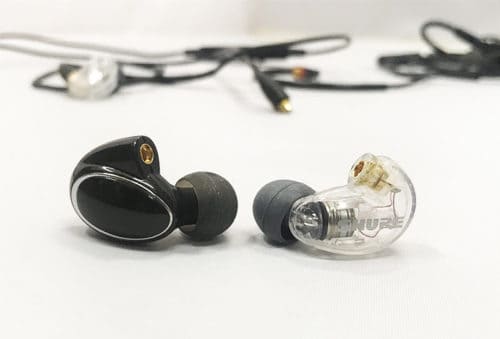
The midrange of the FiiO FH1 and the Shure SE215 certainly had a feeling of similarity, especially in the middle part of the midrange and the high-mids. The biggest difference to my ears in the midrange was that the SE215 had more emphasis in the low-mids. As a result, low-mid rich instruments like guitars, synths, low strings, and basses, sounded bigger with the 215 but clearer with the FH1.
There was another small difference in the high-mids, giving the two IEMs a slightly different shape there from each other. Both had emphasis at the bottom of the high-mids and the top of the high-mids, leaving a space in the middle part of the high-mids. However, the SE215’s cut, which sounded like it was somewhere around 3 kHz felt a bit more dramatic than the cut in the FH1. As a result, vocals felt a little bit louder in the mix with the FH1 than the SE215.
For example, when I was listening to the song City on the Hill by Desaparecidos, the lighter low-mid energy of the FH1 gave the electric guitar more separation from the bass guitar. That said, with the SE215, the guitars and bass sounded bigger, although blended more together. Additionally, the snare drum sounded clearer with the FH1 but had a big sense of heavy energy with the SE215, making it feel powerful.
High Frequencies
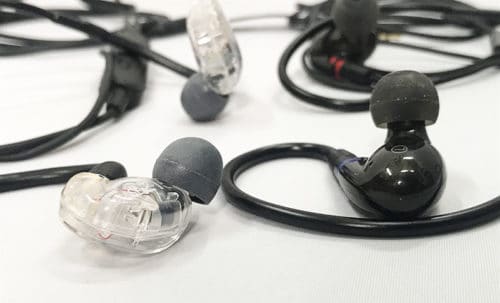
The high frequencies of the FiiO FH1 and the Shure SE215 are the most dramatic differences between the two IEMs– perhaps because of the FH1’s balanced armature driver! In a general sense, this difference presents itself most audibly in the lower treble. Right where the SE215 cuts a bunch of information right around 6-7 kHz, the FH1 boosts. As a result, the FH1 comes across much more articulate than the SE215, whereas the SE215 comes across as much more warm. And while the SE215 boosts other areas of the highs, namely in the upper octave, the FH1’s highs feel louder overall. As a result, it has a nice sense of presence and detail, but because of a little bit of a cut in the upper treble, avoids sibilance and harshness.
Although the highs of the SE215 are quieter than the highs of the FH1, they seem a little bit smoother and more even. The FH1’s highs aren’t radically uneven, but because of they way they are shaped, they limit realism in comparison to the SE215.
For example, when I was listening to the So Tender by Keith Jarrett, the high harmonics of the piano, where the hammers hit, felt louder in the mix than normal with the FH1. Additionally, the attack of the cymbals sounded closer in the space and a little bit thinner than normal. By contrast, the high harmonics of the piano and cymbals had less emphasis but were a little bit more even and realistic sounding with the SE215.
Soundstage
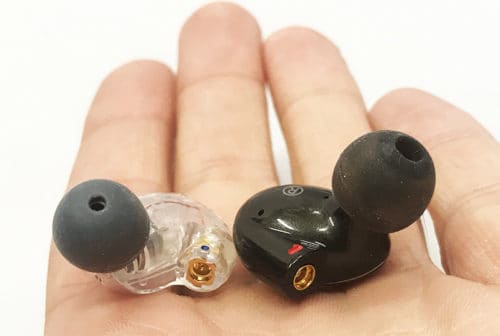
The soundstage of the FiiO FH1 and Shure SE215 had a sense of similarity in regard to their nuance of directionality, but differed in feel based on their differences in frequency response. For example, the FH1 had a more dramatic sense of width because wide-panned instruments with high frequency information like cymbals, guitars, horns, and background vocals sat louder in the mix. Additionally, because the FH1 had a little bit high-mid energy than the SE215, it had a little bit more of a sense of intimacy and closeness in regard to vocal representation. Lastly, the FH1 had a more dramatic sense of height because of the sub emphasis and high frequency emphasis.
By contrast, the SE215 had a greater sense of emphasis on room mics and reverbs because of the way its midrange sat.
For example, when I was listening to the song Lazarus by David Bowie, Bowie’s vocal sounded closer in space with the FH1 than the SE215. Additionally, the contrast between the lows of the kick and the highs of horns, high-hats, and other cymbals sounded more dramatic with the FH1. However, when listening with the SE215, the room microphones of the space where the drums and horns were recorded sounded more emphasized, and thus set the drums more accurately back in space.
Overview
Overall, both the FiiO FH1 and the Shure SE215 are great options for those looking for an affordable pair of IEMs with a detachable MMCX connector. They are super similar in size and shape, but differ in their sound signatures. In a general sense, the SE215 has a warmer sound and the FH1 has a brighter, clearer sound. So if you want an earphone with more clarity in the high end, as well as an option to listen with a balanced cable, go with the FH1. However, if you want more thickness and warm energy, go with the SE215.
The FiiO FH1 and the Shure SE215 are available for the best price here:
MajorHiFi may receive commission through retail offers.
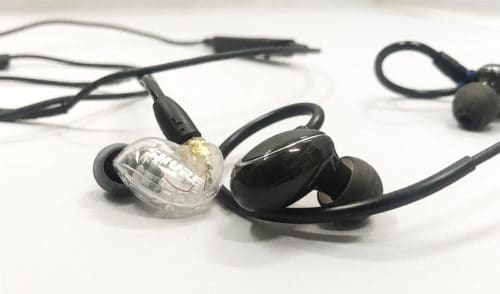
Specifications
| FiiO FH1 | Shure SE215 | |
| Drivers | 1 dynamic, 1 Knowles balanced armature | 1 dynamic |
| Impedance | 26 ohms | 17 ohms |
| Sensitivity | 106 dB/mW | 107 dB/mW |
| Frequency Response | 20 Hz – 40 kHz | 22 Hz – 17.5 kHz |
Compare the ranking of various headphones, earbuds and in-ear monitors using our tools.
Discuss this, and much more, over on our forum.
---MAJORHIFI may receive commissions from retail offers.


